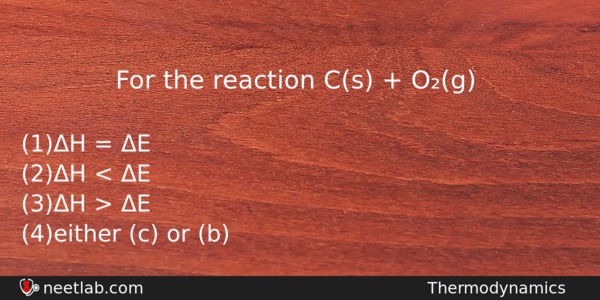| ⇦ | 
| ⇨ |
For the reaction C(s) + O₂(g)
Options
(a) ΔH = ΔE
(b) ΔH < ΔE
(c) ΔH > ΔE
(d) either ΔH > ΔE or ΔH < ΔE
Correct Answer:
ΔH = ΔE
Explanation:
In the reaction C(s) + O₂(g) → CO₂(g), there is no change in the number of moles of gaseous components (Δn = 1 – 1 = 0).
As ΔH = ΔE + ΔnRT. Thus in this case ΔH = ΔE.
Related Questions: - Aluminium oxide is not reduced by chemical reaction since
- The most suitable method of the separation of a 1:1 mixture of ortho-and para
- Which compound show geometrical isomerism
- Reaction of a carbonyl compound with one of the following reagents involves
- Benzaldehyde can be prepared by the hydrolysis of
Topics: Thermodynamics
(179)
Subject: Chemistry
(2512)
Important MCQs Based on Medical Entrance Examinations To Improve Your NEET Score
- Aluminium oxide is not reduced by chemical reaction since
- The most suitable method of the separation of a 1:1 mixture of ortho-and para
- Which compound show geometrical isomerism
- Reaction of a carbonyl compound with one of the following reagents involves
- Benzaldehyde can be prepared by the hydrolysis of
Topics: Thermodynamics (179)
Subject: Chemistry (2512)
Important MCQs Based on Medical Entrance Examinations To Improve Your NEET Score
18000+ students are using NEETLab to improve their score. What about you?
Solve Previous Year MCQs, Mock Tests, Topicwise Practice Tests, Identify Weak Topics, Formula Flash cards and much more is available in NEETLab Android App to improve your NEET score.
Share this page with your friends

Leave a Reply